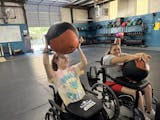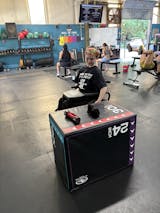GAIT Belts & Adaptive Fitness
🚶♂️ What Is a Gait Belt?
A gait belt (also known as a transfer belt) is a sturdy strap—typically made of nylon, canvas, or leather—that helps caregivers safely assist individuals during transfers or ambulation. Worn snugly around the waist, it offers a secure grip point to help prevent falls and maintain balance. Used in hospitals, rehab settings, and home care, gait belts enhance both patient and caregiver safety. SRA Lab Univ Of Michigan Link
✅ When & Why to Use a Gait Belt
Gait belts are especially useful for people who are partially dependent, such as individuals recovering from surgery, living with mobility limitations, or therapeutic athletes in rehab. Hohman Rehab and Sports Therapy Caregivers use them during transitions — like bed-to-wheelchair or sit-to-stand — and even with walkers or canes. My American Nurse Blog 🩺 Proper placement and training ensure safety:
-
The belt should be snug, over clothing, with room for two fingers between the belt and waist.
-
The person should assist with movement; the belt is not meant to lift. Shirley Ryan Ability Lap YouTube Link
🚫 Risks of Misuse
When gait belts are misadjusted or improperly applied, the very tool designed for safety can cause harm:
-
Misplacement can lead to ineffective support or pressure areas.
-
Too loose, and it may slip; too tight, and it may restrict breathing.
-
Caregiver injury is also risked when belts are used incorrectly (e.g. pulling with the back rather than legs). American NursePerformance Health
💡 Adaptive Fitness Straps: The Modern Evolution
At Equip Products, we take the concept of the gait belt and transform it into adaptive fitness gear for everything from workout movements to seated conditioning.
Our Wheelchair Seatlebelts & Fitness Straps use multiple sizes, neoprene cushioning, and durable kinematics that make movement — including resistance training, therapy, and sport — accessible for people with disabilities.
🔗 Connect Gait Belts to Our Mission
Our Wheelchair Seatbelt & Adaptive Fitness Straps page features straps as effective as the clinical gait belt—but engineered for daily strength, rehab, and adaptive athletics.
Visit: Wheelchair & Fitness Straps →
👟 How to Use a Gait Belt Safely (or Adaptive Strap)
-
Place the belt or strap snugly around the waist or torso (depending on the exercise or support intent).
-
Educate users and caregivers to ensure it rests over clothing—not skin.
-
Use an underhand grip and help with balance—not lifting.
-
For adaptive straps, ensure proper fit and padding to prevent friction or pressure sores (our straps use 4 mm neoprene with soft backing).
🏋️ Why Equip Products Leads in Gait Belt Alternatives
| Feature | Clinical Gait Belt | Equip Adaptive Straps |
|---|---|---|
| Material | Canvas / Vinyl | 4 mm neoprene with soft backing |
| Use case | Transfer & ambulation support | Fitness, resistance, therapy applications |
| Target user base | Clinicians / care facilities | Veterans, adaptive athletes, rehab patients |
| Customized Sizes | Fixed | 20″–70″ options, figure‑eight capable |
✅ Final Thoughts
Whether you’re a caregiver striving for safe transfers or someone pursuing adaptive fitness training, using a gait belt—or an equipment evolution like our adaptive straps—can empower movement with confidence, comfort, and control.
Explore more: Wheelchair Straps & Fitness Gear



